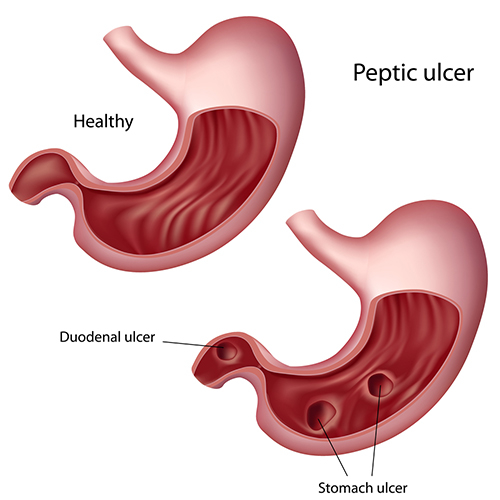
Duodenal Ulcer
The term "duodenum" just describes the portion of your small intestine that joins your stomach to the rest of your small bowels. An ulcer is any break in the epithelium that lines your body. The ulceration in duodenal lining is duodenal ulcer.
Overview
The term "duodenum" just describes the portion of your small intestine that joins your stomach to the rest of your small bowel. That being said, even though it is tiny—about 25 centimetres—in your alimentary canal, which is between 6 and 9 meters long, duodenal ulcers fall under the category of peptic ulcer diseases (PUD), frequently coexisting with gastric ulcers. About 4 million people worldwide are thought to be afflicted with peptic ulcer disease.
Causes
Duodenal ulcers are caused by
Helicobacter pylori infection, a helix-shaped bacterium in the stomach that can cause gastritis and ulcers in developing countries
Non-steroidal anti-inflammatory drugs like aspirin and Ibuprofen increase mucosal irritation.
Stress
Diet
Smoking
Chemotherapy
Crohn's disease also contributes to ulcer development.
Symptoms
A few hours after eating, duodenal ulcers can cause abdominal pain. The pain usually goes away when the effects of acid-reducing foods or medications wear off, but the pain usually comes back. When the stomach is empty, such as after meals at night or first thing in the morning, duodenal ulcer-related abdominal pain may be more severe. Other common peptic ulcer symptoms include:
Indigestion or heartburn
Feeling full even when the stomach is empty
Bloating, gas
Nausea
Some people who have these ulcers develop food intolerances. These foods can make a person feel sick or aggravate ulcer-related symptoms.
Ayurvedic View
The acid peptic disorder is termed 'Amlapitta', meaning 'sour acid', caused due to ajirana (indigestion) and agnimandya (low digestive fire) changes in the monsoon, foods that aggravate pitta dosha. Pitta can be compared to the acid in the stomach called Pachaka pitta. Due to the above-mentioned factors, the pitta attains an intensive, unusual sourness termed as 'vitiation of pitta'. The vitiated pitta causes a burning sensation in the stomach and regurgitation into the oesophagus, leading to a chain of acid-peptic disorders like GERD, Gastric ulcers, and Duodenal ulcers. Duodenal ulcer is a disease where there is a formation of ulcers in the duodenal part of the intestine. When left untreated can cause bleeding, perforation, etc. The ayurvedic protocol aims to correct the digestive fire, bringing pitta back to its normal quality and place and reducing complications. Thereby, we help the patient in managing the Pitta vikara through shamana drugs, which bring a balanced Agni.
Duodenal Ulcer
Treatment for
DISCLAIMER: Listed treatment details are only for information purposes. Treatments and duration may vary depending on numerous factors. Treatments for your condition may not be limited to this list.






















